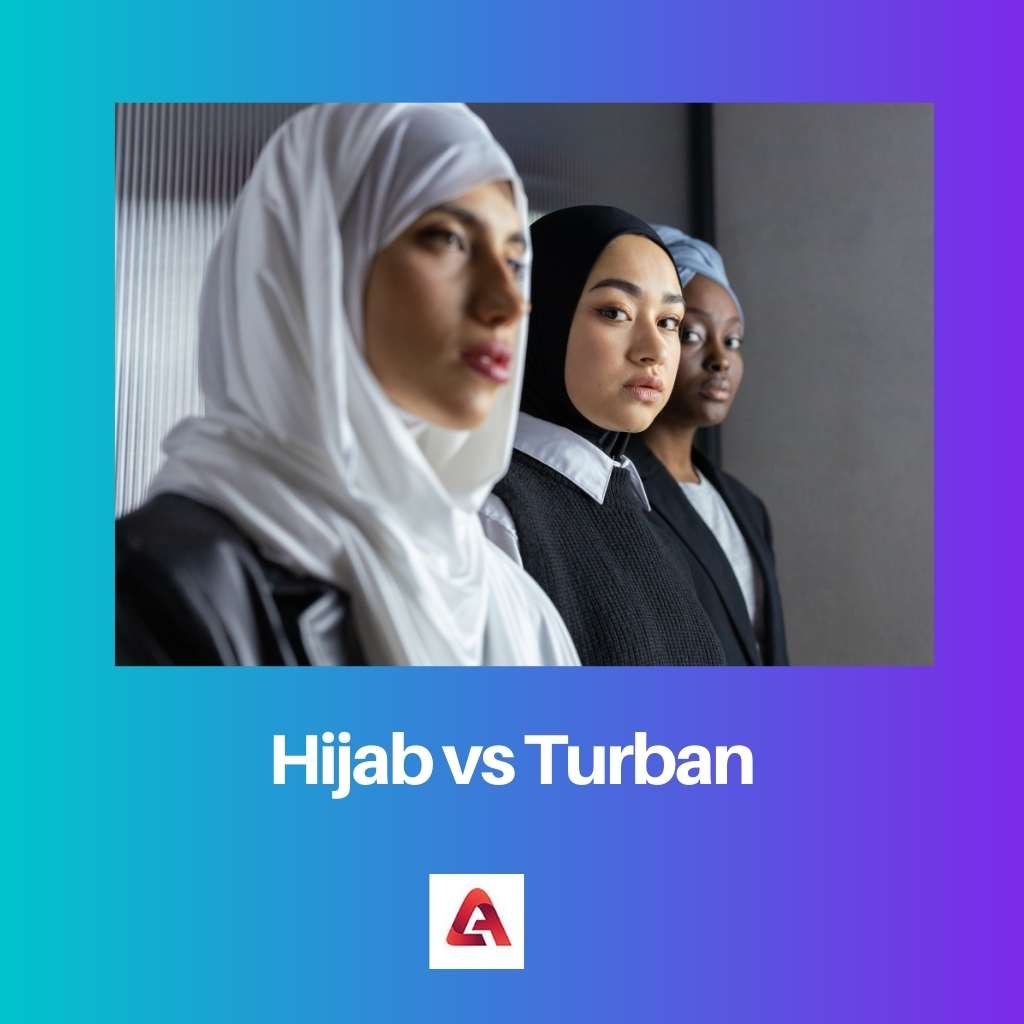The world is home to a variety of major and minor faiths. People of several religions use religious symbols to show their loyalty to their Godfather. Hijab and turban are two different types of headgear that represent two distinct religions.
The Sikh religious people are the most common wearer of the turban. Moreover, Shia male Muslims also wear turbans. In the Muslim religion, the hijab is a well-known garment that covers the head and neck of the female.
Key Takeaways
- Hijab and Turban are head coverings worn for religious, cultural, or personal reasons.
- A Hijab is a headscarf that covers the hair and neck, whereas a turban is a headwrap that covers the entire head.
- Muslim women wear hijabs, whereas men and women of various cultures and religions wear turbans.
Hijab vs Turban
A hijab is a headscarf that covers the head and neck, but leaves the face exposed. It is worn by Muslim women as a sign of modesty and privacy. Turban, is a type of headwear that is based on cloth winding. It is wrapped around the and has various different cultural and religious meanings.

Hijab is a garment, or a veil worn by Muslim women to cover their heads and neck in front of males and other strangers. Some Muslim women wear hijab only in front of strangers in a public place.
Some wear to seclude themselves from the males. This custom has been observed since 657 C.E.
The concept of wearing a turban has been originated in Persia, where Shia male Muslims covered their head with a turban.
Moreover, the followers of Guru Nanak Dev (the founder of Sikhism) also wear a turban as their religious symbol. A turban is also a well-known headgear among Hindu monks.
Comparison Table
| Parameters of Comparison | Hijab | Turban |
|---|---|---|
| Found In | Hijab was founded in the year 657 C.E. | Turban has been founded in 2350 BC. |
| Gender | Females wear the hijab. | Turban can be worn by both males and females, as per the beliefs. |
| Introduced Into | Hijab firstly appeared in Arabia. | Turban first appeared in Persia (Iran). |
| Religion | Hijab is associated with Islam. | Turban is associated with multiple religions. |
| Covers | The hijab covers the woman’s head, ear, and full neck. | Turban covers the head and ear of the wearer. |
What is Hijab?
In Quran, the hijab means a curtain that drew a partition between visitors and Muhammad’s wife’s room. Following Quran, females were required to cover themselves in the presence of strangers and men.
It implies that ladies should wear modest clothing.
So, the hijab is a piece of garment worn by Muslim women. It is somewhat like a veil but, it does not veil the face. It looks like a women’s scarf. It is a traditional part of Muslim women’s dress.
It has been known before the Muhammad period in Arabia. That time, it signified the social status of the people. The rich Muslims could afford to buy the hijab for secluding their body from head to neck, excluding the face.
In some countries (Afghanistan, Iran, some provinces of Indonesia), hijab is compulsory for women. In such places, if a woman does not wear the hijab, she is considered to be insulting the religion and committing a sin.
On the other hand, in some countries, the hijab has been banned in modern times. It is because a few Islamic regions consider that hijab takes away women’s freedom and individuality.
In some nations, including (Saudi Arabia and India), it is women’s choice whether they want to add hijab in their dress style or not.

What is Turban?
Turban is headwear that was first invented in Persia (Iran) as a part of the Muslim religion. It was worn by Sunni Muslims to cover their head and also as a symbol of pride. This custom is well-known in Asian and African countries.
Moreover, Mohammad Prophet (founder of Islam) wore a white color turban during his lifetime. So many Muslim kings wore the turban (a cap containing cloth tied around the head).
However, many Muslim men wear green colored turbans, which is considered a symbol of paradise.
A turban is a headgear of the followers of the Sikh religion. Sikhs wear a turban to cover their long hair with a cloth as Sikhs do not cut their hair.
Moreover, Sikhs consider a turban as their pride and honor. Mostly Sikh men wear a turban. However, a few Sikh girls wear turbans for covering their heads.
Guru Nanak Dev and the other nine Sikh Gurus also wore a turban to protect their hair.
Different Sikhs tie turban in different styles by making layers, as per their area. Popular styles are Amritsar Shahi, Barnala Shahi, Vattan Wali Turban, and Taksali Dumala.
Hindu monks also wear a turban around the head by wrapping a saffron cloth around their heads. The idea behind wearing a turban is to protect their head from direct heatstroke and cold as they stay outdoors.

Main Differences Between Hijab and Turban
- Women wear the hijab. However, a turban is mostly worn by men, and some Sikh women also wear it.
- A hijab has been known since the late 600s CE. On the other hand, the turban has been known since 2350 BC.
- A hijab is a part of clothing to help women in covering themselves in public and front of men. On the other hand, a turban is a symbol of pride.
- A hijab is a garment that covers the woman’s entire head and neck. On the contrary, a turban covers the head of the wearers.
- A hijab is related to Islam. However, a turban is associated with multiple religions (Islam, Sikhism, and Hinduism).

- https://www.sciencedirect.com/science/article/pii/S0022103108000681
- https://www.tandfonline.com/doi/abs/10.1080/13537901003750894
